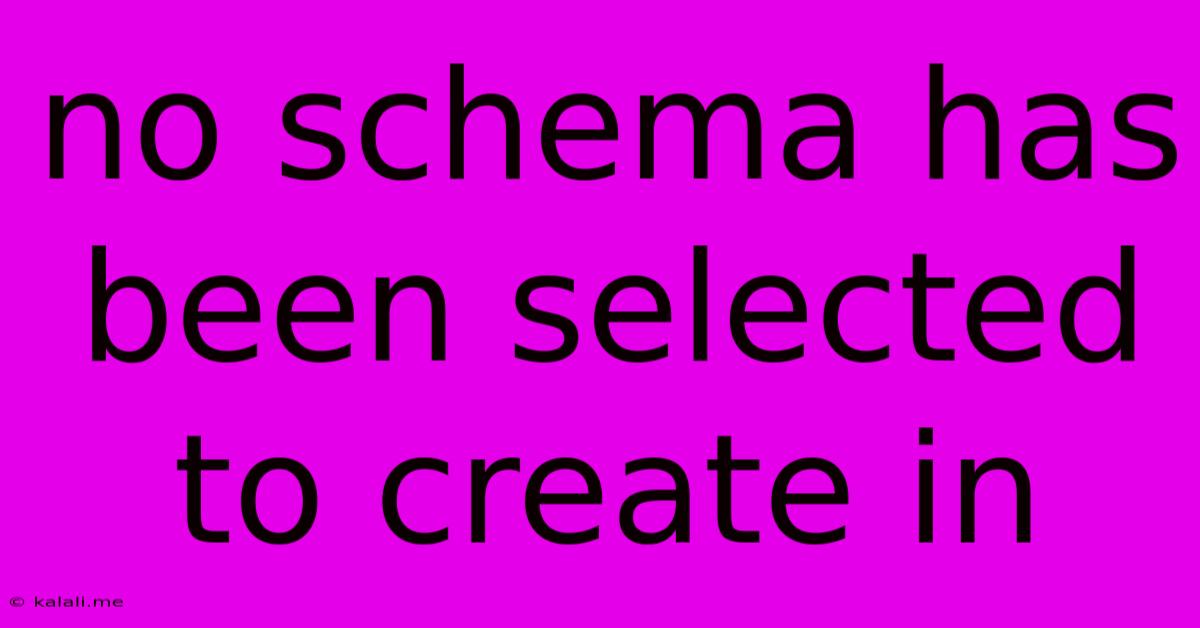No Schema Has Been Selected To Create In
Kalali
Jun 02, 2025 · 4 min read

Table of Contents
No Schema Has Been Selected: Troubleshooting WordPress and Other CMS Issues
Choosing the right schema markup is crucial for your website's SEO. When you encounter the error "No schema has been selected," it means your website isn't using structured data to tell search engines what your content is about. This article will guide you through troubleshooting this problem in WordPress and other Content Management Systems (CMS), offering solutions to get your schema implemented correctly.
What is Schema Markup and Why is it Important?
Schema markup, also known as structured data, is code you add to your website's HTML that helps search engines understand the content on your pages. This helps them display richer search results, often including things like star ratings, images, and snippets of text. Using schema can lead to increased click-through rates (CTR) and improved organic rankings. Failing to select a schema means search engines don't get the full picture of your content, potentially hindering your SEO performance. This lack of structured data prevents search engines from understanding the context and meaning behind your content, leading to lower visibility.
Common Causes of the "No Schema Has Been Selected" Error
The "No schema has been selected" error can stem from several issues:
- Plugin Conflicts: If you're using multiple SEO plugins or conflicting plugins, they might interfere with schema implementation. One plugin might override the settings of another, resulting in the error.
- Incorrect Plugin Setup: Even with a dedicated schema plugin, improper configuration can lead to this problem. Ensure the plugin is correctly installed and activated, and that all necessary settings are configured correctly.
- Theme Conflicts: Your website theme might have its own schema implementation or conflict with a schema plugin.
- Coding Errors: If you're manually adding schema markup to your website's code, errors in the code can prevent it from working correctly.
- Missing or Incorrect Schema.org Vocabulary: Your schema might not be using the correct vocabulary from schema.org, the official schema vocabulary.
Troubleshooting Steps:
1. Identify the Source of the Error:
- Check your SEO plugin: If you are using a plugin for SEO (like Yoast SEO or Rank Math), check its settings for schema markup. Look for a section dedicated to schema settings. It's possible you haven't selected a schema type or the plugin hasn't been configured properly.
- Inspect your website's code: Use your browser's developer tools (usually accessed by pressing F12) to inspect your website's HTML source code. Look for
<script type="application/ld+json">tags. These tags contain your schema markup. The absence of these tags or incorrect code within them will cause the error. - Use a Schema Markup Validator: Tools like Google's Rich Results Test can help you validate your schema markup and identify any errors. This tool allows you to paste your schema code or enter your URL to check for validity and potential issues.
2. Resolve Plugin Conflicts:
- Deactivate conflicting plugins: Temporarily deactivate all SEO plugins except one to see if the error persists. If the error disappears, you know there was a conflict. Try activating one plugin at a time to find the culprit.
- Update your plugins: Ensure all your plugins are up to date to avoid compatibility issues.
3. Correct Plugin Setup:
- Review your plugin settings: Carefully review the settings of your chosen schema plugin. Make sure you've selected the appropriate schema type(s) for your content. Different page types (e.g., articles, products, events) require different schema types. Incorrect schema implementation will result in errors and potentially no schema being selected.
- Check for plugin documentation: If you are unsure about how to set up your plugin, consult its documentation or support resources.
4. Address Theme Conflicts:
- Switch to a default theme: Temporarily switch to a default WordPress theme (like Twenty Twenty-Three) to see if the theme is interfering with schema implementation.
5. Correct Coding Errors:
- Use a code editor: If you're manually adding schema, use a code editor that highlights syntax errors, making it easier to spot mistakes. Ensure proper syntax and correct schema vocabulary.
6. Verify Schema.org Compliance:
- Consult the Schema.org website: Ensure you're using the correct properties and types from the official Schema.org vocabulary. Incorrect use of properties can cause issues.
By systematically going through these troubleshooting steps, you should be able to resolve the "No schema has been selected" error and successfully implement schema markup on your website, improving its SEO performance and visibility in search engine results. Remember to test your changes frequently using tools like Google's Rich Results Test. Consistent monitoring and testing are key to ensuring your schema remains effective.
Latest Posts
Latest Posts
-
2015 Hyundai Sonata Limited Engine Doesnt Go Beyond 60
Jun 04, 2025
-
Kitchen Sink Drain Already Has A White Gasket
Jun 04, 2025
-
Where To Star Watching Vampire Diaries Without Missing Important Things
Jun 04, 2025
-
How To Find Average Value Of A Function
Jun 04, 2025
-
Is The Cramer Von Mises Distance A Metric
Jun 04, 2025
Related Post
Thank you for visiting our website which covers about No Schema Has Been Selected To Create In . We hope the information provided has been useful to you. Feel free to contact us if you have any questions or need further assistance. See you next time and don't miss to bookmark.